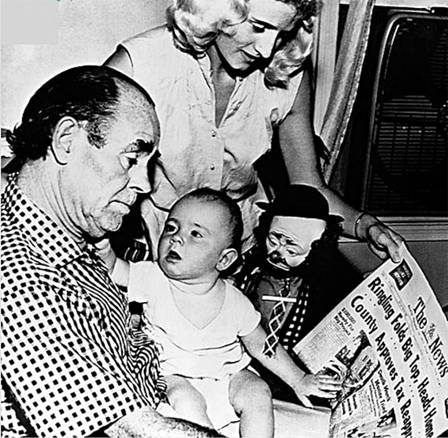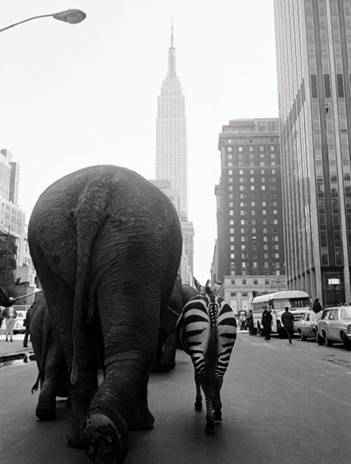Ancient Hixtory
December 2020: Finally, A Real Circus! - 1950s: Ringling Bros. and Barnum & Bailey
- Details
- Ronald Wencer
- Category: Ancient Hixtory
- Hits: 2944
Article Pages
To my knowledge, none of the largest circuses pulled their circus trains into Hicksville and performed there between 1921 and 1951.If I am wrong, I'll be happy to be corrected.
After the war, circuses again enjoyed great popularity - not just with working people, but also with the wealthy and the famous.Newspapers regularly showed international celebrities attending American circuses (e.g., the Duke of Windsor and his American Duchess, Wallis Simpson).Actors and comedians frequently got to perform in them, especially for charity performances.
Ms Monroe at Madison Square Garden c.1950 in the Ringling
Brothers and Barnum & Bailey Circus.The elephant and its
harness were dyed pink to match her costume.
NewYorkSocialDiary.com
RBB&B included Hicksville in its 1951 tour.To put this in context, and to appreciate the magnitude of the 1951 version of this circus, let's consider some statistics.That year, the circus performed at 121 locations, gave 333 performances under canvas, and traveled more than 17,000 miles, from Boston to Seattle to Baton Rouge, and then across the south to its Florida home.At each stop, it needed 15 empty acres on which to erect its 41 tents.There were more than 1,200 employees in the tour, and almost 1,100 animals.
The circus train's 70 cars (together, more than 1.1 miles long) were of course parked in the rail yard south of Barclay Street ; the performance was held in an open field further west, on John Street .

New York Daily News, June 8, 1951
As the caption above indicates, the three-day stop in Hicksville was one of RBB&B's numerous charitable performances, in this case coordinated with Long Island 's American Legion posts.The conveniently nearby site used for the circus grounds was not going to be available for long.In fact, it should not have been available at all. Hicksville developer Jerry Spiegel had intended to build new homes on it, but there had been a recent government change in funding GI mortgages, and he had stopped building homes in protest.Thus, he was able to "donate" the use of land (which he was not using anyway) to the fund-raising effort.
At this point, the reader probably does not need a description of more circus acts.I shall instead note that the 1952 film The Greatest Show on Earth was shot during the early part of this circus's 1951 tour; thus, the non-actor performers who appear in the film are the actual workers and performers whom people saw on the 1951 tour.Incidentally, Greatest was the top-grossing Paramount film of all time, as well as the top-grossing film of the year, and it won 1952's Best Picture Oscar for Cecil B. deMille.

were sideshow attractions for many
years.The Kayan people of Burma
still use progressively taller coils of
brass to gradually deform the clavicles
of growing girls, thus shortening their
ribcages to make their necks look longer.
ebay.com

1951 RBB&B Circus Program cover
James Stewart, Cornel Wilde, and Charlton
Heston in The Greatest Show on Earth; one
never sees Stewart without clown makeup
during the film
Note: The film is in color; this must be a
publicity photo intended for newspapers.
Wikimedia.org
Five years later, the 1956 version of the same circus performed in Hicksville .Externally, things may have looked much the same, but they were very different. Hicksville had changed; choice temporary circus grounds were scarce.RBB&B performed for two days on a field at Old Country and South Oyster Bay Roads.More important, the circus was wrestling with serious labor disruptions, and it was in the process of laying off a number of "offstage" workers. Whether or not the layoffs were to blame is debatable, but something went wrong.

New York Daily News, June 14, 1956
The Times reported that all the injuries were minor contusions, and that the cause of the accident was the young elephant's tripping over some hard-to-see safety netting that lay in its path.As with other such incidents, people later tended to recall this mishap in somewhat inflated terms, especially if they were children at the time.
The labor issues were the result of the circus owners' intentions to cut costs long-term.Among their options, they considered switching the circus from its train to highway travel, a change which would have affected literally everyone in the circus.Ultimately, that idea was dropped, because it would not have been cost-effective.
On the other hand, RBB&B did decide to do away with its tents - after 1956, its tour would stop only in arenas.This change would be drastic, but it was understandable.In 1951, the circus had played only at three indoor venues ( Madison Square Garden , Boston Garden , and the San Francisco Cow Palace ). The rest of the time - 79% of the year's performances - the Big Top was in a country town, or on the undeveloped edge of city in a rural region.By 1956, suburbia was becoming well established in that kind of territory, and it was getting difficult to find convenient 15-acre lots.From the owners' viewpoint, the circus would draw just as many people by playing in arenas built for sports as it would in Big Tops.
Of course, there would be a significant impact on the other stakeholders - the audiences and the employees.The "circus experience" would be very different.Rural townsfolk would no longer have the excitement of seeing the circus train arrive, and watching the parade (although the performance in the arena would feature an indoor parade, to be viewed from a distance, not from curbside).Driving some miles to an arena might be all right, but enduring traffic jams, and finding parking spots, were not part of the old circus experience.Besides, when people attended a circus in an arena, they wouldn't be sharing the experience with the rest of their hometown and with their extended family.The circus would no longer feel like a shared personal or community experience.
For employees, the change would be even more disruptive.It would affect livelihoods.Someone who'd spent a couple of decades, say, expertly erecting the Big Top, or inspecting it for damage and making repairs by hand, and whose living quarters were provided by his employer, was not likely to find himself qualified for a different job that offered comparable benefits.And what about circus families?A hypothetical equestrian performer whose husband had worked in a tent crew now faced a crisis.Would the circus still house her family on the train, including her unemployed husband, or would he have to settle somewhere with the children while she traveled, and be a homemaker and father, living in a home they might not be able to afford?

Legendary RBB&B clown Emmett Kelly, and his wife read the news
reports of the circus's unexpectedly ending its season prematurely,
and also announcing that its Big Top would be no more.Years
later, their son Emmett Jr. would try starting his own circus.
NewYorkSocialDiary.com
For reasons not necessarily clear, layoffs began during the tour.Perhaps it was a question of the circus's "getting rid of [perceived] troublemakers," or maybe it was a decision to economize (e.g., because long-term tent maintenance was no longer needed, fewer employees were required).Either way, the layoffs exacerbated the unrest.Things apparently boiled over only a month after the circus left Hicksville .On July 16, 1956, during its scheduled stop at Pittsburgh , Ringling Brothers and Barnum & Bailey decided to end its season prematurely.Its Big Top days were over.
Although this biggest of American circuses would thrive for another half-century and more, its efforts to remain relevant in a changing society ultimately failed.It never again performed in Hicksville , of course.When its time came, it died a mere six miles away.

Old friends, out for a nice stroll
NewYorkSocialDiary.com

